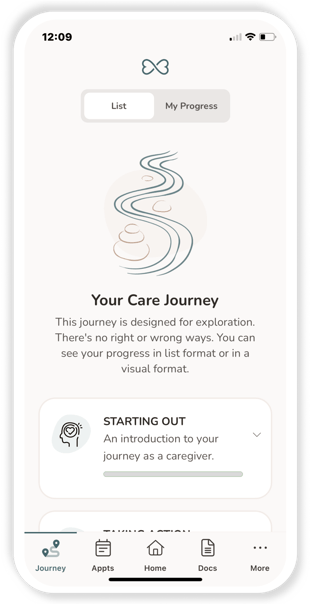Caregiven helps you on your caregiving journey
The Caregiven app provides 24/7 access to the knowledge, tools and support you will need most when providing care for another adult, while also sustaining your own emotional well-being.
BUILDING THE FOUNDATIONS
People before numbers
Qualities and skills embodied by employees who are also caregivers are characteristics every employer desires. Retaining and attracting caregivers is not only good for the employee — it’s good for your business:
Employee caregivers are:
-
Excellent communicators able to listen, negotiate, read body language, and interpret other forms of nonverbal communication. They are also adept at effectively speaking with different professions including medical, insurance, financial and legal advisors.
-
Critical thinkers who are adaptable and willing to learn. They draw on solid research skills, with a higher-than-average tolerance of change and uncertainty to make logical, well-informed decisions.
-
Forward thinking optimists in the face of hard facts, drawing on their resolve and resilience to move forward despite setbacks and challenges.
-
Leaders who step up to the plate in difficult situations and are used to conflict management resulting in positive resolutions. They hone the art of managing difficult conversations and have the ability to quickly address issues.
-
Team players who work collaboratively to achieve the best outcomes, demonstrating a high work ethic and level of commitment.
IMPACT ON THE BOTTOM LINE
Numbers add up
The Caregiver Impact Number is based on analysis of absenteeism, presenteeism, retention, and increased healthcare costs considered standard metrics for understanding the economic impact caregiving has on an employee's ability to perform.
We would be remiss in not highlighting other factors which aren't easily quantified in economic terms, but are nonetheless significant to organizations:
-
lost competitive advantage due to turnover,
-
inability to use benefits as a differentiator for candidates,
-
the impact on diversity and inclusivity initiatives as caregiving falls more heavily on women, and
-
higher risk of Family Responsibilities Discrimination or other employee complaints.
View group impact information based on number of employees
Annual Impact of Unsupported Caregivers
Lost Time From Unsupported Caregivers
For less than $1,000 per month, Caregiven enables mid-market employers to restore employee productivity by 72%.
Caregiven's Impact
How we calculated
Caregiven sourced the most relevant national reports and statistics on caregiving to develop the Caregiver Impact Number. Included in our calculations are the following datapoints:
-
We assumed 20% of employees are engaged in caregiving.
-
Annual compensation was set at $56,250.
-
Caregivers have on average 11 more days of unplanned absences then their non-caregiver counterparts.
Presenteeism for caregivers has been benchmarked at 18%. -
Annual health insurance premiums are 8% higher for caregivers than those who aren’t.
-
Nationally over 60% of employees change their position or leave their careers entirely due to caregiving commitments. To be conservative, we assumed 5% of employees with caregiving obligations will leave their role.
-
Replacement time was established at 6 months.

CARING FOR YOUR EMPLYOEES
You can make an impact
We all want to help our team members and their families, particularly when life events are complex and overwhelming. However, the decision to include a new employee benefit often comes down to economics. Will the solution save time and money? Will it retain employees?
Caregiven can assist your business by:
-
Providing guidance and support to employees to help them proactively reach out to their supervisors and/or Human Resources department to discuss their role as a caregiver, avoiding any potential miscommunications or hard feelings.
-
Enabling users to streamline communication, decrease endless search time, and worry less by tracking what’s happening with their care recipient — all resulting in more employee focus while at work.
-
Prioritizing the emotional well-being of each user so they feel less overwhelmed and stressed at work.

